Here and there – and probably not for long – you can still find a new vehicle that at least offers something larger than a 2.0 liter turbocharged four cylinder engine.
Chevy’s Blazer is one such – though probably not for much longer and not because the 3.6 liter V6 burns a lot of gas. In fact, it hardly uses more gas than the – you guessed it! – 2.0 liter turbocharged four cylinder engine that’s standard in this vehicle.
The V6’s sin – in the eyes of EPA regulators – is that it “emits” too much gas. Carbon dioxide. The gas that doesn’t cause air pollution or harm the environment and which plants process into the oxygen we need to breathe (and live) but which is claimed to be causing the “climate” to “change” – whatever that means.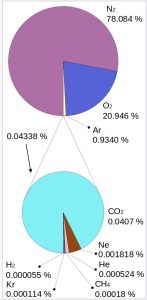
Well, it does mean one thing. Fewer (and soon, no more) V6s. And once those are gone, no more turbocharged fours, either.
Until all that’s available is 1,000 pound battery packs and electric motors – irrespective of the effect that producing, powering (and throwing away) these things has on the environment.
In the meanwhile, if you still want an engine – and one with more than four cylinders – the clock is ticking.
What It Is
The Blazer is a mid-sized, five-passenger crossover that’s similar to lots of others – with one exception:
It is still available with a V6 engine.
Others in the same size/price range – like the Toyota Highlander and Subaru Ascent – are now four cylinder only.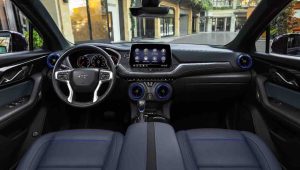
The Blazer’s base price is $35,400 for the 2LT trim with front-wheel drive (and a 2.0 liter, turbocharged four cylinder engine). AWD is available as a stand-alone option. If you want it, the MSRP climbs to $38,100.
A top-of-the-line Premier trim with AWD lists for $45,700. This one also comes with the 2.0 liter engine.
If want a V6 engine, it’s standard in the $42,800 RS. A performance-minded torque-vectoring AWD is also available optionally. So equipped, the Blazer RS’s MSRP is $45,700. The RS Blazer also comes with more aggressive 20-inch wheels and low-profile tires, an upgraded Bose audio system and unique-to-this model blackout trim.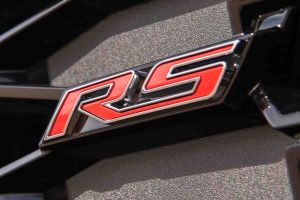
What’s New For 2024
Heated seats are now standard in all Blazer trims.
What’s Good
You can still get a V6.
Many “advanced driver assistance” features are optional – and so avoidable.
Back seats have almost as much legroom as front seats.
What’s Not So Good
You can’t get the V6 in any trim other than the RS (and it’s a $7k price bump to get the RS vs. the base 2LT).
No third row option (several in the class, including the Highlander) offer that.
Lane Keep Assist is standard – and so unavoidable.
The Blazer’s standard engine – a turbocharged 2.0 liter four cylinder – is similar to the engines that are becoming standard in almost everything. The reason for that being that a turbocharged 2.0 liter four is just large enough (and just powerful enough) to be enough to adequately power most vehicles – but don’t emit too much gas (C02) to cause problems for the manufacturer with the government.
The Chevy’s 2.0 four produces 228 horsepower and 258 ft.-lbs. of torque at 1,500 RPM. This is enough to get the 3,918 lb. Blazer to 60 in just over 7 seconds. A nine speed automatic is standard. This combo rates 22 MPG in city driving and 29 MPG on the highway.
The four cylinder-powered Blazer can pull a 3,200 lb. trailer.
If you want to be able to pull more (5,000 lbs.) and haul (0-60 in just over 6 seconds) you’ll probably be more interested in the Blazer RS, which comes standard with a version of the 3.6 liter V6 that’s also used in the Camaro sport coupe. The Blazer’s version makes 308 horsepower and 270 ft.-lbs. of torque at 5,000 RPM (vs. 335 horsepower and 284 ft.-lb.s of torque at 5,300 RPM).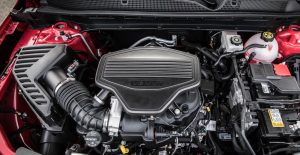
Interestingly, there’s almost no mileage penalty to be paid for choosing the V6 over the turbo’d four. Equipped with the 3.6 liter engine, a Blazer RS rates 19 city, 26 highway – a difference (on paper) of about 3 MPG. In real-world driving, the mileage differences narrows to almost none because the turbo four will only deliver on its touted mileage numbers if you don’t make much use of the turbo. But that is very hard to do – unless you don’t mind driving at a Prius-like pace. If you don’t – and push down on the accelerator pedal to get some acceleration, the turbo will boost the four to give it the power needed to accelerate at faster than a walking pace. But it takes energy to make power – and that entails burning more gas to make it.
The fulsome scurvy truth is that were it not for the government and the C02 “emissions” regs car manufacturers must comply with, a mid-sized vehicle pushing tow tons such as the Blazer would not even offer a turbo’d four as there’s no benefit (vs. a V6) for the buyer.
They’d come standard with a V6 – as such vehicles used to. The four is the Blazer’s standard engine for compliance reasons only. And for the same reason, the V6 is limited to just one Blazer trim, the RS.
This is done – perversely – in order to avoid selling too many V6 Blazers, as that negatively affects Chevy’s compliance with the government’s regs pertaining to C02 “emissions.”
On The Road
If you look at the Blazer RS you’ll get an idea about how it drives before you drive it. The resemblance to the Camaro is more than stylistic. The Camaro’s V6 is part of the story but so also the lower ride height (and roofline) vs. other crossovers in the class.
The RS sits a relatively low (for a crossover) 7.5 inches off the ground and its roofline is just 67 inches off the ground. A Kia Telluride (which is a crossover styled to look more like an SUV) rides 8 inches off the ground and stands just shy of two inches taller (68.9) than a Blazer RS.
Being lower to the ground, as the Blazer is, helps it to hug the ground – around the curves – better than the typical crossover. And the V6 gives it the power to exit the curves in Camaro-like fashion.
You can use the manual shift control function to prevent a premature mid-corner upshift and hold second or third as you exit the corner and run the V6 up to about 6,500 – at which point the rev limiter prevents it from spinning any faster. Drop a gear – and do it again. This is the kind of fun you can still have in a crossover with a Camaro’s V6.
The Camaro-like 20 inch wheels and thin-sidewall sport tires that are part of the RS package also deliver a firm, Camaro-like ride as well as quick-feeling response to steering inputs. Just be careful about curbs and potholes as these short-sidewall tires are more vulnerable to damage (and so are are the wheels, which are expensive to replace when damaged).
Be aware, too, that the RS is a compromised crossover relative to the others. The reduced ground clearance and performance tires that give it a handling (and fun) advantage over more practical crossovers with more ground clearance and all-season tires will be a disadvantage when it snows.
We’ve already delved into the Blazer’s Camaro-esque looks (and driving feel). Now let’s look at one of the consequences of those good looks.
Like the Camaro – though not as severely – the lower roofline costs backseat headroom. There’s a comparatively low-slung 38.6 inches for the backseaters, which is about an inch-and-a-half less headroom than in the backseats of more formally styled crossovers like the Kia Telluride (which has 40.2 inches of backseat headroom, which is slightly more headroom than the 39.8 inches of front seat headroom in the Blazer).
It might not matter if you – and those who will ride in this vehicle – are under six feet tall. But for those who are taller, it could be a problem. This is one of those things you have to try-it-and-see, for yourself – as vehicles are a lot like clothes and you can’t really know whether it’s a good fit until you try them on.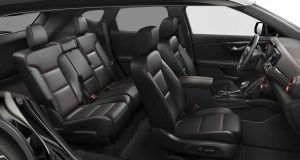
RS Blazers get a Darth Vader black-painted grill and matching exterior trim and the instrument cluster is still analog and (once again) Camaro-like, with a large speedometer dominating the layout, a large tach off to the left and smaller accessory gauges interspersed among them. Like the V6, it is a lingering relic of the Before Time – i.e., the time before vehicles began to transition into smartphone-emulating devices.
There is, on the other hand, the now-unavoidable device erupting from the dashboard like a Pop Tart. These LCD touchscreens are becoming like 2.0 liter fours in that everyone has them and – as such – they are part of the dreary trend toward turning every vehicle into a device. 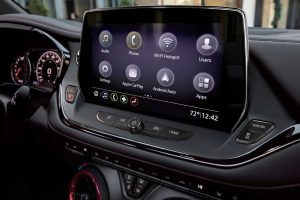
Chevy does not offer a third row in this vehicle and total cargo capacity – 64.2 cubic feet – is significantly less than is available in the Toyota Highlander (84.3 cubic feet) which also offers a third row and seven passenger capability. But you can’t get a V6 in the four-cylinder-only Highlander. The Kia Telluride (and its Hyundai Palisade cousin) are probably this Chevy’s heaviest competition. Both come standard with a third row and a V6 – and each have a total of 87 cubic feet of cargo space with their second and third rows folded down.
An interesting lateral comparison shop is the electric version of the Blazer. It stickers for $51,800 and for that you get 288 horsepower (20 less than the V6 in the non-EV Blazer RS) and a maximum range of 280 miles – if you drive it mostly in the city, at lower-than-highway speeds. The V6 Blazer RS can go more than 500 highway miles (368 in “city” driving) and Blazers with the 2.0 liter four cylinder engine can go close to 600 highway miles (426 in “city”) driving.
And you’ll pay about $10k more for the battery-powered version of the Blazer, on top of that.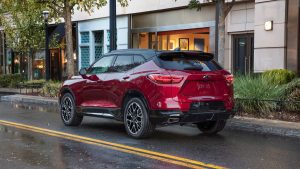
This is what you can look forward to when you you can no longer buy the V6 (or even turbo four-powered) Blazer, after Chevy transitions over to selling only battery powered devices.
The Bottom Line
A standard V6 in a mid-sized crossover used to be as expected as floor mats in an economy car. Soon, a V6-powered mid-sized crossover could be as exotic as a V12 -powered ultra-luxury sedan was just a handful of years ago.
. . .
If you like what you’ve found here please consider supporting EPautos.
We depend on you to keep the wheels turning!
Our donate button is here.
If you prefer not to use PayPal, our mailing address is:
EPautos
721 Hummingbird Lane SE
Copper Hill, VA 24079
PS: Get an EPautos magnet or sticker or coaster in return for a $20 or more one-time donation or a $10 or more monthly recurring donation. (Please be sure to tell us you want a magnet or sticker or coaster – and also, provide an address, so we know where to mail the thing!)
If you like items like the Keeeeeeev T shirt pictured below, you can find that and more at the EPautos store!






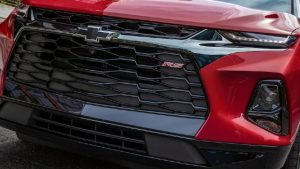
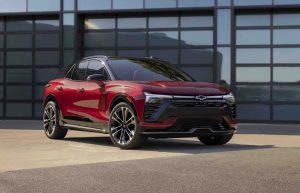






Mary Barra needs to be bitch-slapped for the stupid shit she does. A night in a nearby shelter belt will change her mind, might as well be naked all night long. You know how it always is and goes.
Do you raise chickens or do you just go to the grocery store to buy your chicken thighs?
Makes me cry when I decapitate a chicken’s head, later on, I eat the fried chicken thighs, they’re good, salt, pepper, garlic, just the way it is in this world.
Think of the chickens!
I wish my income had grown at the pace of new car prices. 51K for a modern PoS is just mind numbing.
Ain’t that Texas cookin’ something?
Keeps your belly and backbone from bumping.
All apologies to Guy Clark.
That is why you have an income.
Oh for God’s sake. This is a ‘Blazer”? This looks like the same Persian Slipper POS thingy you reviewed last week. Another Nissan Murano/Juke bean-pod toe-nail space-ship wanna be.
Of course, this garbage wouldn’t be complete without the 20″ Ghetto Wheels.
One could tell a Blazer from far away in the 1990s and early 2000s. Now it looks like any generic crossover.
Chevy lost me at lane keep assist
‘The RS sits a relatively low (for a crossover) 7.5 inches off the ground.’ — eric
Did you know that for regulatory purposes, the Chevy Blazer probably is classified as a ‘light truck’? Troof!
‘If you examine these rules closely, a shocking number of vehicles fit. Let’s take, for example, the Subaru Crosstrek. Legally, the Subaru Crosstrek is a light truck. Congratulations.
‘With that light truck classification comes the benefit of less-strict mileage standards. There’s a reason why light trucks accounted for nearly 80 percent of new vehicles sold last month: Almost every crossover or SUV with AWD for sale today is a light truck.’
https://www.thedrive.com/news/small-cars-are-getting-huge-are-fuel-economy-regulations-to-blame
Victoria Scott’s article explains many things: why AWD proliferates; why high ground clearance vehicles proliferate too; and most important, why the dependence of CAFE on footprint (with lower numbers for larger footprints) has decimated the number of compact cars and wiped out compact pickups completely.
Purblind fedgov regulation is a tragedy for automotive design. Even what few models of interest remain are being taken away by the jackbooted CAFE police. Resist. And bitch like hell …
GM can call that car a Blazer all they want. It ain’t a Blazer. Several years ago when GM announced the return of the Blazer, people including myself thought they were going to bring the retro 4×4 back. Boy that was a huge disappointment. Getting in bed with the government tends to tarnish one’s image. So I guess you’re left thinking about the times you could buy what you wanted new or restore the old one today. Nice job GM!
Ford took the Maverick badge, which applied to a 1970s compact car of mixed reputation, and pasted it onto a car-based pickup.
Whereas GM took the Blazer badge of Chevy’s legendary C/K trucks and stuck it onto a generic, me-too crossover.
Why didn’t they call this crossover, say, the Impala (another legendary, market-dominating brand that GM degraded to dust)?
EeeVee Mary … you’re an idiot.
I think the reason why the new Challengers were so successful for so long is because they were designed as a modern version of the original Challenger, with the same general physical characteristics.
Of the big 3, Dodge did the best retro design, keeping the spirit of the original namesake. I have seen some online pictures where people laid the photos out of the 70’s model and the modern model side by side, and they were very similar.
This new “Blazer” is akin to some of the woke Disney remakes that share absolutely no attributes with the original stories that made Disney great in the beginning. The makers of such have lost all touch with their history, and the success that history of excellence had afforded them.
Thing looks like a Toyota (Nipponese for “ugly”) with a bow tie Chevy badge on the front. Gack.
Same issue with the new Defender, instead of a fun update with styling and off-road capability like the tried and true 90/110 series, they did an urban style knockoff that just pissed off the Land Rover loyalists. Shoulda had the MOPAR folks do these updates! They got it right with the Challenger.
The only thing they got wrong was not bringing back the gear reduction starters for the Challengers & Chargers.
Nice to know a v6 can still be had. Act now.
However, the pic of St Greta triggered an epiphany. She’s actually the real life embodiment of Billy Mumy in Twilight Zone. Check it out, if you dare…
https://www.imdb.com/title/tt0734580/
Hi Mark,
I’d forgotten about that episode – thanks for the reminder! I’d also forgotten it starred Billy Mumy from Lost in Space. Danger! Danger Will Robinson!
… and don’t trust Dr Zachary Smith
Hi Greg,
Yup! Much as I now despise him, Howard Stern did a hilarious parody of Lost in Space, with Dr. Smith cast a lecherous old pedophile scheming to seduce Will Robinson.
She would send us all to the cornfield if she could.
No. Frau Greta is the embodiment Brother Isaac from the 1984 film adaptation of “Children of the Corn”.
https://www.youtube.com/watch?v=Fq0HV6Aaopo